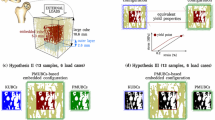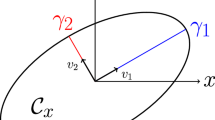Abstract
Nonlinear computational analysis of materials showing elasto-plasticity or damage relies on knowledge of their yield behavior and strengths under complex stress states. In this work, a generalized anisotropic quadric yield criterion is proposed that is homogeneous of degree one and takes a convex quadric shape with a smooth transition from ellipsoidal to cylindrical or conical surfaces. If in the case of material identification, the shape of the yield function is not known a priori, a minimization using the quadric criterion will result in the optimal shape among the convex quadrics. The convexity limits of the criterion and the transition points between the different shapes are identified. Several special cases of the criterion for distinct material symmetries such as isotropy, cubic symmetry, fabric-based orthotropy and general orthotropy are presented and discussed. The generality of the formulation is demonstrated by showing its degeneration to several classical yield surfaces like the von Mises, Drucker–Prager, Tsai–Wu, Liu, generalized Hill and classical Hill criteria under appropriate conditions. Applicability of the formulation for micromechanical analyses was shown by transformation of a criterion for porous cohesive-frictional materials by Maghous et al. In order to demonstrate the advantages of the generalized formulation, bone is chosen as an example material, since it features yield envelopes with different shapes depending on the considered length scale. A fabric- and density-based quadric criterion for the description of homogenized material behavior of trabecular bone is identified from uniaxial, multiaxial and torsional experimental data. Also, a fabric- and density-based Tsai–Wu yield criterion for homogenized trabecular bone from in silico data is converted to an equivalent quadric criterion by introduction of a transformation of the interaction parameters. Finally, a quadric yield criterion for lamellar bone at the microscale is identified from a nanoindentation study reported in the literature, thus demonstrating the applicability of the generalized formulation to the description of the yield envelope of bone at multiple length scales.






Similar content being viewed by others
References
Arramon YP, Mehrabadi MM, Martin DW, Cowin SC (2000) A multidimensional anisotropic strength criterion based on Kelvin modes. Int J Solids Struct 37:2915–2935
Bayraktar HH, Gupta A, Kwon RY, Papadopoulos P, Keaveny TM (2004) The modified super-ellipsoid yield criterion for human trabecular bone. J Biomech Eng 6:677–684
Carnelli D, Gastaldi D, Sassi V, Contro R, Ortiz C, Vena P (2010) A finite element model for direction-dependent mechanical response to nanoindentation of cortical bone allowing for anisotropic post-yield behavior of the tissue. J Biomech Eng 132(8):081008
Carnelli D, Lucchini R, Ponzoni M, Contro R, Vena P (2011) Nanoindentation testing and finite element simulations of cortical bone allowing for anisotropic elastic and inelastic mechanical response. J Biomech 44(10):1852–1858
Cowin SC (1979) On the strength anisotropy of bone and wood. J Appl Mech 46(4):832–838
Cowin SC (1985) The relationship between the elasticity tensor and the fabric tensor. Mech Mater 4(2):137–147
Cowin SC (1986) Fabric dependence of an anisotropic strength criterion. Mech Mater 5:251–260
Cowin SC (1989) Bone mechanics. CRC press, Boca Raton, FL
Cowin SC, He QC (2005) Tensile and compressive stress yield criteria for cancellous bone. J Biomech 38(1):141–144
Curnier A (1994) Computational methods in solid mechanics, vol 29. Springer, Berlin
Drucker D, Prager W (1952) Soil mechanics and plastic analysis or limit design. Q Appl Math 10:157
Fratzl P, Weinkamer R (2007) Nature’s hierarchical materials. Prog Mater Sci 52(8):1263–1334
Gelfand IM, Kapranov MM, Z A (1994) Discriminants, resultants and multidimensional determinants. Birkhuser, Boston
Gibson L (1985) The mechanical behaviour of cancellous bone. J Biomech 18(5):317–328
Gupta H, Zioupos P (2008) Fracture of bone tissue: the ’hows’ and the ’whys’. Med Eng Phys 30(10):1209–1226
Harrigan TP, Mann RW (1984) Characterisation of microstructural anisotropy in orthotropic materials using a second rank tensor. J Mater Sci 19:761–767
Hellmich C, Ulm F-J (2002) Are mineralized tissues open crystal foams reinforced by crosslinked collagen? Some energy arguments. J Biomech 35(9):1199–1212
Hildebrand T, Laib A, Müller R, Dequeker J, Rüegsegger P (1999) Direct three-dimensional morphometric analysis of human cancellous bone: microstructural data from spine, femur, iliac crest, and calcaneus. J Bone Miner Res 14(7):1167–1174
Hill R (1951) The mathematical theory of plasticity. Oxford University Press, Oxford
Kanatani K-I (1984) Distribution of directional data and fabric tensors. Int J Eng Sci 22(2):149–164
Keaveny TM, Morgan EF, Niebur GL, Yeh OC (2001) Biomechanics of trabecular bone. Annu Rev Biomed Eng 3(1):307–333
Kristic R (1991) Human microscopic anatomy. Springer, Berlin
Liu C, Huang Y, Stout M (1997) On the asymmetric yield surface of plastically orthotropic materials: a phenomenological study. Acta Mater 45(6):2397–2406
Maghous S, Dormieux L, Barthélémy JF (2009) Micromechanical approach to the strength properties of frictional geomaterials. Eur J Mech A 28(1):179–188
Matsuura M, Eckstein F, Lochmüller E-M, Zysset P (2008) The role of fabric in the quasi-static compressive mechanical properties of human trabecular bone from various anatomical locations. Biomech Model Mechanobiol 7:27–42
Mehrabadi M, Cowin S (1990) Eigentensors of linear anisotropic elastic materials. Q J Mech Appl Math 43(1):15–41
Parfitt A (1984) Age-related structural changes in trabecular and cortical bone: cellular mechanisms and biomechanical consequences. Calcif Tissue Int 36:S123–S128
Prager W, Drucker D (1952) Soil mechanics and plastic analysis or limit design, 0. Appi Math 10(2):157–165
Reisinger A, Pahr D, Zysset PK (2010) Elastic anisotropy of bone lamellae as a function of fibril orientation pattern. Biomech Model Mechanobiol 10(1):67–77
Rho JY, Kuhn-Spearing L, Zioupos P (1998) Mechanical properties and the hierarchical structure of bone. Med Eng Phys 20(2):92–102
Rincón-Kohli L, Zysset P (2009) Multi-axial mechanical properties of human trabecular bone. Biomech Model Mechanobiol 8:195–208
Shih CF, Lee D (1978) Further developments in anisotropic plasticity. J Eng Mater 100(3):294–302
Smith CI, Faraldos M, Fernández-Jalvo Y (2008) The precision of porosity measurements: effects of sample pre-treatment on porosity measurements of modern and archaeological bone. Palaeogeogr Palaeoclimatol Palaeoecol 266:175–182
Tai K, Ulm F-J, Ortiz C (2006) Nanogranular origins of the strength of bone. Nano Lett 6(11):2520–2525
Tsai S, Wu E (1971) A general theory of strength for anisotropic materials. J Compos Mater 5(1):58–80
von Mises R (1913) Mechanik der festen Körper im plastisch deformablen Zustand. Göttin Nachr Math Phys 1:582–592
Wang R, Gupta HS (2011) Deformation and fracture mechanisms of bone and nacre. Annu Rev Mater Res 41:41–73
Wang X, Allen MR, Burr DB, Lavernia EJ, Jeremic B, Fyhrie DP (2008) Identification of material parameters based on Mohr–Coulomb failure criterion for bisphosphonate treated canine vertebral cancellous bone. Bone 43(4):775–780
Weiner S, Wagner HD (1998) The material bone: structure-mechanical function relations. Annu Rev Mater Sci 28(1):271–298
Whitehouse W (1974) The quantitative morphology of anisotropic trabecular bone. J Microsc 101:153–168
Wolfram U, Gross T, Pahr D, Schwiedrzik JJ, Wilke H-J, Zysset PK (2012) Fabric based Tsai-Wu yield criteria for vertebral trabecular bone in stress and strain space. J Mech Behav Biomed 15:218–228
Yeni Y, Dong X, Fyhrie D, Les C (2004) The dependence between the strength and stiffness of cancellous and cortical bone tissue for tension and compression: extension of a unifying principle. Biomed Mater Eng 14(3):303–310
Zysset PK (2003) A review of morphology-elasticity relationships in human trabecular bone: theories and experiments. J Biomech 36:1469–1485
Zysset PK, Curnier A (1995) An alternative model for anisotropic elasticity based on fabric tensors. Mech Mater 21(4):243–250
Zysset PH, Rincón L (2006) An alternative fabric-based yield and failure criterion for trabecular bone. In: Holzapfel GA, Ogden RW (eds) Mechanics of biological tissue, Springer, pp 457–470
Acknowledgments
This work was supported by the University of Bern and a Ph.D. scholarship of the German National Academic Foundation.
Author information
Authors and Affiliations
Corresponding author
Electronic supplementary material
Rights and permissions
About this article
Cite this article
Schwiedrzik, J.J., Wolfram, U. & Zysset, P.K. A generalized anisotropic quadric yield criterion and its application to bone tissue at multiple length scales. Biomech Model Mechanobiol 12, 1155–1168 (2013). https://doi.org/10.1007/s10237-013-0472-5
Received:
Accepted:
Published:
Issue Date:
DOI: https://doi.org/10.1007/s10237-013-0472-5




